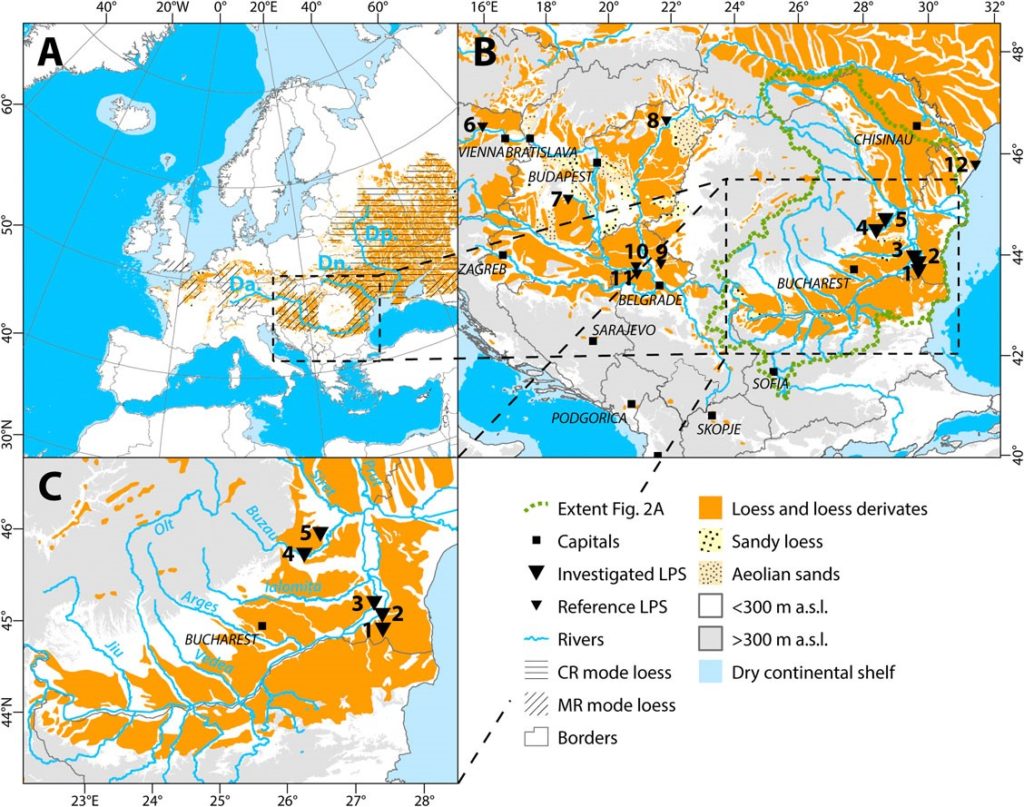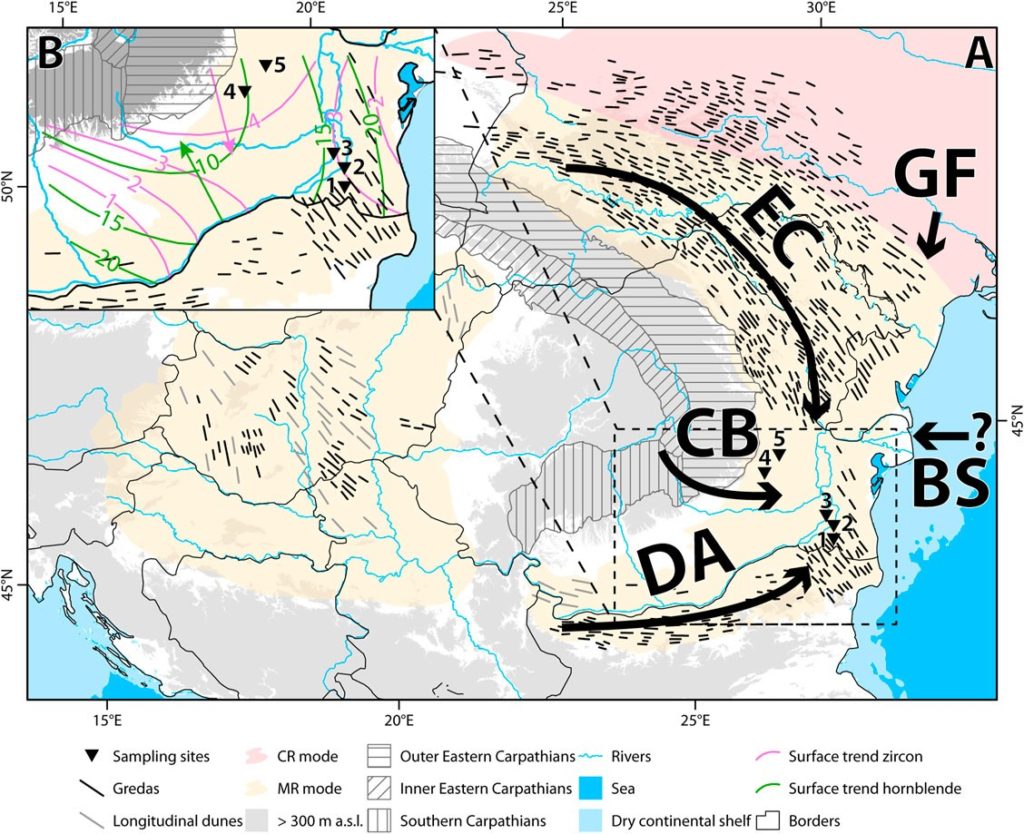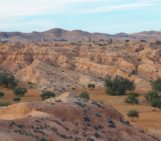
Previous blog posts have highlighted the importance of loess as an indicator of climate and environmental changes in the past. These posts showed the relevance of loess deposits as archives of Pleistocene climates and environments, the importance of using novel approaches in mapping these and other Quaternary-related sediments, the aspects of dating loess deposits, as well as the peculiarities of desert loess. Here, we present you the findings published in Frontiers in Earth Science1. In this study, we used bulk geochemical data of loess deposits to reconstruct dust particle generation and transport pathways in the Lower Danube Basin (LDB) in southern Romania.
Loess provenance as an archive of past wind directions
The formation of windblown dust deposits, termed as “loess” by Quaternary geologists, involves a multitude of geomorphological and sedimentological processes. Wind cannot provide enough energy to produce sufficient amounts of detrital silt for loess formation. Therefore, glacial, periglacial and fluvial activities are important factors in the complex sedimentary history of loess2. Mineral dust can, e.g., be produced by glacial grinding in high-altitude areas, transported to lowlands by rivers and finally entrained by erosive winds. Although, the definition of loess was heavily debated by our scientific community3, researchers generally agree on this terminal transport of dust particles by wind4. Therefore, constraining past dust transport pathways may enable to reconstruct dominant wind directions during dust deposition.
To reconstruct wind directions, several approaches can be applied. Firstly, one can investigate the imbrication, i.e. the dominant orientation of grains in a sediments or sedimentary rocks, which is recorded by magnetic properties of the deposit5,6. This proxy allows the reconstruction of the direction in which the grains were deposited during the terminal aeolian transport and, therefore, reflects the dominant wind direction. Secondly, sedimentological7, mineralogical8, or geochemical9 properties can be used to fingerprint loess deposits and potential help determine the source sediments. Moreover, single grain provenance analyses, such as the detrital zircon Uranium (U)-Lead (Pb) ages can be used to pinpoint original source terranes of terrestrial sediments10. The knowledge about source regions, together with insights to the complex sedimentary history of loess, can be used to reconstruct sedimentary pathways and, therefore, infer past wind directions.
Potential sedimentary pathways for the Lower Danube loess
The loess deposits of the Lower Danube Basin are amongst the most complete terrestrial paelaeoclimate archives11. However, until recently, no systematic, proxy data-based study regarding the provenance of these vast loess deposits has been conducted. Nevertheless, assumptions about the potential sediment sources have been made, based on sedimentological, mineralogical, and geomorphological observations12 suggesting five sedimentary pathways:
Alluvial sediments of the Danube form the most obvious source of silt-sized dust particles in the Lower Danube Basin and are therefore considered an important dust source. The flysch areas of the Carpathian Bending are drained by sediment-rich rivers, which built up large systems of alluvial fans, posing another potential source region for uptake of dust by wind. The Cretaceous to Neogene flysch sediments, as well as widespread unconsolidated fluvial, aeolian, and shallow marine sediments of Late Miocene to Quaternary age are eroded and transported by large tributaries of the Danube, such as the Prut or Siret rivers. Also, these alluvial sediments may serve as potential deflation areas for dust particles in the LDB. Furthermore, silt sources from glaciofluvial outwash plains of the large continental ice sheets in central Ukraine as well as the Black Sea shelf exposed during Pleistocene sea-level low-stands may have contributed to the Lower Danube Basin loess deposits.

Figure 1: Aeolian sediments in (A) Europe, (B) Southeastern Europe and (C) the Lower Danube Basin. Numerals indicate loess-palaeosol sequences (LPS) mentioned in the original publication. The here investigated LPS are 1 – Urluia (URL), 2 – Rasova (RAS), 3 – Vlasca (VLA), 4 – Sageata (SAG) and 5 – Balta Alba Kurgan (BAK)1.
Sediment fingerprinting: A comparative geochemical approach to study loess provenance
From the previously mentioned methods in loess provenance research, elemental geochemistry poses a relatively fast and low-cost approach. For our study1, we analysed the geochemical composition of five loess-palaeosol sequences (LPS) from the LDB, roughly covering the marine isotope stages13 (MIS) 3 to 1. These LPS are all located in the eastern part of the basin, arranged in a SE-NW transect from the Dobrogea Plateau to the foreland of the Carpathian Bending. We compared the results to evaluate similarities and differences between the respective profiles. Subsequently, we compared these results to findings from several LPS across reference regions in the MDB, as well as from southwest Ukraine. To assure comparability of the geochemical data, we only included samples analysed in the Physical Geography Laboratory of RWTH Aachen University, Germany. Given the lack of direct provenance studies from the LDB, we linked the results to published studies in the areas we used as reference regions to evaluate the importance of the described sedimentary pathways for the Lower Danube loess.
Our results (Fig. 2 for example) demonstrate remarkable similarities between the southern sites we investigated (URL, RAS, VLA), indicating geochemically similar source materials. Furthermore, the geochemical composition resembles the data from reference regions upstream of the Danube, where provenance studies have identified the Danube alluvium as the main dust source, implying that this is also the case for loess deposits in the lower Danube basin. Generally, the investigated loess deposits further north (SAG and BAK) show overlaps with the aforementioned sites, as well as with reference regions upstream, indicating input of alluvial material originating from the Danube. However, differences in major oxide compositions of these deposits, compared to the geochemical signature of the Danube material suggest additional sourcing from geochemically different source regions. As seen in the K2O/Al2O3 vs. Na2O/Al2O3 and the K2O/Al2O3 vs. SiO2/TiO2 plots in Fig. 2, these two sites seem to overlap with LPS from the Ukrainian Black Sea shore, indicating similar source regions. For the Dniester Valley tributary rivers that erode the Eastern Carpathian mountains and their forelands have been established as the major sediment source for loess deposits14. Based on the geochemical similarities to the regions which are used for comparison, such as southern Ukraine, detrital material from the Eastern Carpathians can be assumed as primary sediment source for these sites. As our sedimentological analyses revealed, the Sageata LPS consists of relatively coarse material (see our paper1 for details). Coarse aeolian deposits are unlikely to be transported by winds over long distances. Therefore, and based on the geochemical distinctiveness of this site (see, e.g., the Al2O3/TiO2 vs. Fe2O3/TiO2 plot in Figure 2), local sediment sources, mainly from the rivers draining the Carpathian Bending, played a major role for loess formation in this region.

Figure 2: Exemplary bi-plots of geochemical compositions of the investigated LPS (URL: Urluia; RAS: Rasova; VLA: Vlasca; SAG: Sageata; BAK: Balta Alba Kurgan). The geochemical data from the reference regions upstream the Danube (Lower Austria, Balaton, Bükk Mountains, Vojvodina) as well as from Ukraine (Black Sea Shore) are shown as dotted lines. Extreme outliers influenced by high contents of the Campanian Ignimbrite tephra are marked with the letter T. For further data and figures, the reader is referred to the original publication1.
Dust in the wind – palaeoclimatic implications of provenance studies
The geochemical evidence together with the general geomorphological setting allowed us to establish three major sedimentary pathways for the loess of the Lower Danube Basin: Firstly, the transport and deposition of detrital material by the Danube and its major tributaries, which was subsequently deflated by wind (DA in Figure 3), acted as a major pathway and especially dominated in the southern parts of the basin. Secondly, the Carpathian Bending pathway (CB in Fig. 3), where material originated from the sediment-rich rivers draining the area; and lastly the Eastern Carpathians pathway (EC in Figure 3), where flysch is eroded and transported by the large Danube tributaries Siret and Prut. The glaciofluvial (GF) and the Black Sea pathways cannot be evaluated in detail due to the lack of reference data. But what do these findings tell us about the past climate evolution in the region?
The dominance of the Danube alluvium pathway in the southern basin indicates a mostly westerly wind-driving dust deflation and transport. This is in accordance with geomorphological evidence from loess dunes, so-called gredas, which can be found throughout the study area. South of the Danube, these gredas are usually west-east oriented. The same applies for the Eastern Carpathians pathway, where our data supports the evidence of vast greda fields, which are sub-parallel to the mountain front indicating north-westerly winds. The general west-trend in the wind direction can be explained by an intensification of the Siberian High-pressure system, which pushed the dominant westerlies southwards and intensified the orographic effects of the Carpathian Mountains. The Carpathian Bending pathway indicates that local wind systems also played a crucial role in aeolian deflation.
Limitations and future work
Our results gave us a tentative overview of sedimentary pathways accounting for loess deposits in the Lower Danube Basin. However, to disentangle the complex sedimentary history of the Lower Danube loess in more detail, further work needs to be done. The bulk geochemical data presented here may be affected by the mixing of several sediment sources. Single grain detrital zircon U-Pb dating, e.g., could help reconstruct the complete sedimentary cycle, including recycling of older deposits. In addition to the reconstruction of potential source areas, analysing the anisotropic magnetic susceptibility of loess deposits would help us to better understand the terminal aeolian transport of loess deposits. Lastly, the knowledge about sedimentary pathways should be supplemented with detailed multi-proxy approaches to unravel the post-depositional alterations of loess deposit and gain insights into palaeoclimatic conditions not only during deposition but also afterwards.
This blog was edited by the editorial board.
References:[1] Pötter, S. et al. Disentangling sedimentary pathways for the Pleniglacial Lower Danube loess based on geochemical signatures. Front. Earth Sci. 9, 1–25 (2021). [2] Pötter, S. The sedimentary history of loess : sources, deposition, and reworking of aeolian sediments as indicators for palaeoenvironmental changes in the Danube Basin. (RWTH Aachen University, 2021). [3] Sprafke, T. & Obreht, I. Loess: Rock, sediment or soil – What is missing for its definition? Quat. Int. 399, 198–207 (2016). [4] Pye, K. The nature, origin and accumulation of loess. Quat. Sci. Rev. 14, 653–667 (1995). [5] Zeeden, C. & Hambach, U. Magnetic susceptibility properties of loess from the Willendorf archaeological site: Implications for the syn/post-depositional interpretation of magnetic fabric. Front. Earth Sci. 8, (2021). [6] Költringer, C. et al. Palaeoenvironmental implications from Lower Volga loess - Joint magnetic fabric and multi-proxy analyses. Quat. Sci. Rev. 267, 107057 (2021). [7] Nottebaum, V., Stauch, G., Hartmann, K., Zhang, J. & Lehmkuhl, F. Unmixed loess grain size populations along the northern Qilian Shan (China): Relationships between geomorphologic, sedimentologic and climatic controls. Quat. Int. 372, 151–166 (2015). [8] Wolf, D. et al. Origins and genesis of loess deposits in central Spain, as indicated by heavy mineral compositions and grain-size variability. Sedimentology 66, 1139–1161 (2019). [9] Campodonico, V. A., Rouzaut, S. & Pasquini, A. I. Geochemistry of a Late Quaternary loess-palaeosol sequence in central Argentina: Implications for weathering, sedimentary recycling and provenance. Geoderma 351, 235–249 (2019). [10] Fenn, K. et al. Insights into the provenance of the Chinese Loess Plateau from joint zircon U-Pb and garnet geochemical analysis of last glacial loess. Quat. Res. 89, 645–659 (2018). [11] Marković, S. B. et al. Danube loess stratigraphy — Towards a pan-European loess stratigraphic model. Earth-Sci. Rev. 148, 228–258 (2015). [12] Jipa, D. C. The conceptual sedimentary model of the Lower Danube loess basin: Sedimentogenetic implications. Quat. Int. 351, 14–24 (2014). [13] Pillans, B. QUATERNARY STRATIGRAPHY | Chronostratigraphy. in Encyclopedia of Quaternary Science 2811–2819 (Elsevier, 2007). doi:10.1016/B0-44-452747-8/00073-9. [14] Pańczyk, M., Nawrocki, J., Bogucki, A. B., Gozhik, P. & Łanczont, M. Possible sources and transport pathways of loess deposited in Poland and Ukraine from detrital zircon U-Pb age spectra. Aeolian Res. 45, 100598 (2020).





